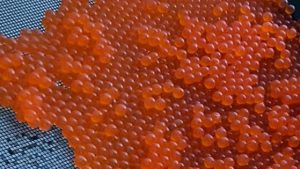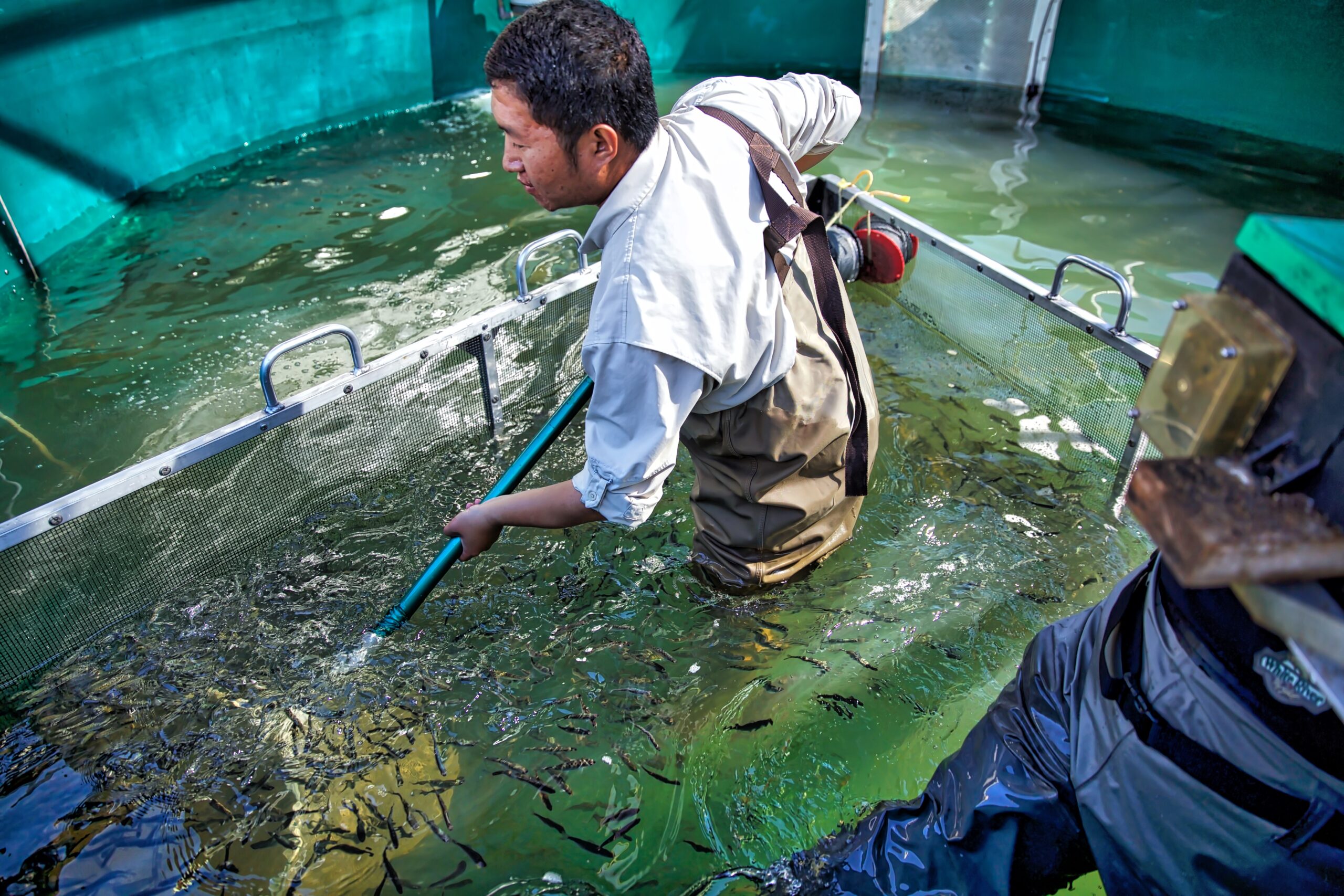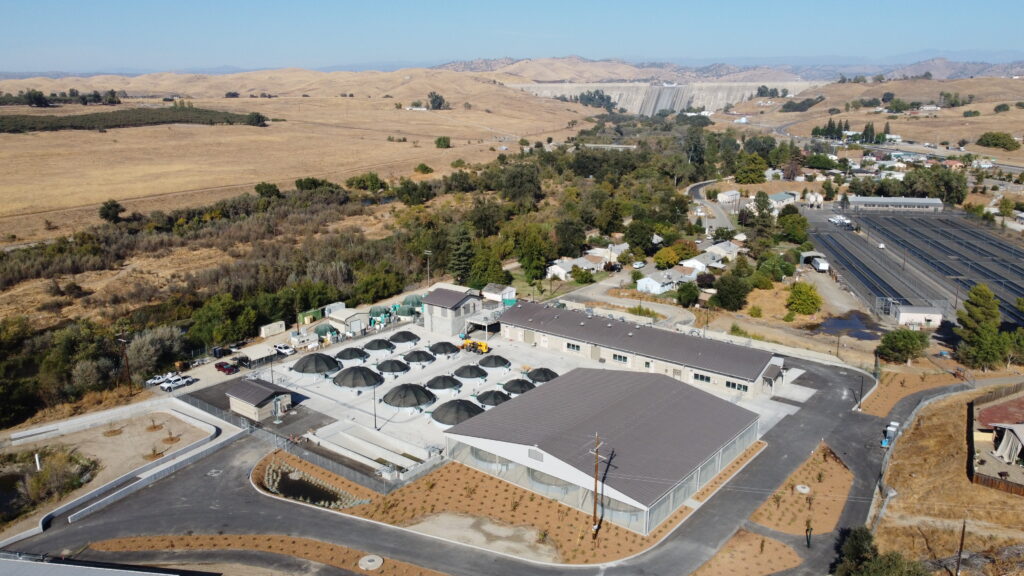Reintroduction
As part of the San Joaquin River Restoration Program, routine year-round monitoring of fish throughout their lifecycle is conducted in the Restoration Area.
San Joaquin River spring-run Chinook salmon evolved to live in both fresh and salt water environments. Hatched from an egg in rivers, streams and creeks, they advance as fry, parr, and eventually juveniles, rearing and growing larger, until they emigrate to the cooler tidal water of the Sacramento-San Joaquin Delta and to the Pacific.
Some of the generation hold back and stay in the freshwater systems for an additional year – known as “yearlings” – when they migrate to ocean the following year.
This is thought to be a resiliency life history strategy in response to environmental conditions, such as drought.
Once the juveniles (or yearlings) migrate to the ocean, they mature into adults before migrating back to their natal stream, where they spawn and die, completing their lifecycle.
Spring-run are unique from other runs of salmon in that adults typically arrive in early spring (April), hold all summer in Reach 1, close to the dam, while not eating, before spawning in late fall (Sept. – Oct.) and dying.
Spring-run Chinook Salmon Lifecycle

Coordination for fish reintroduction efforts takes place through the Fisheries Management Work Group. A consortium of Implementing Agency staff, the group is responsible for planning and coordinating to implement the fisheries components of the Restoration Goal.
Actions include assisting with broodstock collection and monitoring of potential donor populations; providing input and guidance for fisheries studies, including passage assessments; providing input and guidance for the operation of the Hills Ferry Barrier, flow scheduling and water temperature management; document preparation and submission; and technical input to various Program efforts.
The Fisheries Reintroduction and Restoration Team works closely with the Fisheries Management Work Group in coordinating and completing any permitting requirements to implement the fisheries reintroduction portion of the Settlement and associated studies. It is responsible for planning and coordination of regulatory documents and activities associated with reintroduction of fish into the San Joaquin River through the SJRRP. The members include National Oceanic and Atmospheric Administration Fisheries, California Department of Fish & Wildlife, the US Fish & Wildlife Service, and Reclamation.
Adult Fish
The Program raises adult spring-run Chinook salmon at the Interim Salmon Conservation and Research Facility (ISACRF) in order to develop a San Joaquin River-specific population of fish. Adults are raised from eggs at the ISCARF where their eggs (female) and milt (male) are collected at adulthood and used to artificially spawn the next broodyear of salmon.
A number of ancillary broodstock, those determined not needed for spawning operations, are released to the river annually. To increase data about spawning habitats and behaviors, acoustic telemetry tags are implanted in the released hatchery adult broodstock (as well as naturally returning spring-run adults) to track their movements within the river. In 2022, for the first time, Program staff released broodstock adults at Freemont Ford – the southernmost release point for adult broodstock to date for the Program – in order to test the furthest extent of their spawning range. Below is a video of a Program field staff releasing a broodstock adult spring-run Chinook salmon to the San Joaquin River below Skaggs Bridge in Fresno County.
Juvenile Fish
A critical component of re-establishing a population of naturally reproducing and self-sustaining spring-run Chinook salmon in the San Joaquin River is by developing a juvenile population for release into the river.
Since spring-run Chinook were extripated from the river in the early 1950s following the construction of Friant Dam, the SJRRP has been working to create a new population of this species in the river.

To achieve that desired result, a process to mimic the natural spawning that occurs in the wild takes place at the Interim Salmon Conservation and Research Facility by the California Department of Fish and Wildlife. At the facility, located just a couple of miles below Friant Dam, eggs are harvested from fully-grown adult female spring-run, fertilized with male donors, incubated, hatched and raised in captivity until they are released as juveniles. Program spring-run Chinook are spawned using both the eggs generated at the SCARF as well as eggs gathered at the Coleman Fish Hatchery on the Feather River which has an existing spring-run population. The expectation is that over time, the San Joaquin River will have its own unique genetic stock of spring-run Chinook salmon.

The Program began releasing broodstock juvenile spring-run Chinook salmon unique to the San Joaquin River in 2016 and since that time has released over a million fish. A small number of these fish have transmitters surgically implanted in order to allow scientists to track their movements, learn about survival rates, habitat usage and determine other scientific information that will help to establish a stable population.
Conservation Facility
Public funding from voter-approved state bonds Proposition 84 and Proposition 1, are being combined with $17 million of Proposition 13 funds from the Department of Water Resources’ Riverine Stewardship Program, to fund construction of the new $40 million Salmon Conservation and Research Facility (SCARF). The project is currently in the final stages of construction.

The Salmon Conservation and Research Facility (SCARF) is owned and operated by the California Department of Fish & Wildlife (CDFW) and is located about 1-mile downstream of Friant Dam. The facility was funded by over $40M in voter-approved state bonds from Proposition 84, Proposition 1, and Proposition 13 from the Department of Water Resources’ Riverine Stewardship Program. The SCARF currently produces about 250,000 juvenile spring-run Chinook salmon annually and will eventually produce approximately 1 million spring-run Chinook salmon juveniles for the SJRRP. The SCARF is part of a broad suite of actions needed to meet the Program’s Restoration Goal.
In addition to collecting eggs from adult broodstock raised at the hatchery, eggs or juveniles are transferred to the SCARF each year from northern California streams where spring-run Chinook exist. By drawing from other spring-run genetic pools around the state, CDFW works to rear salmon that are genetically diverse in order to develop a San Joaquin River-specific population of spring-run Chinook.
